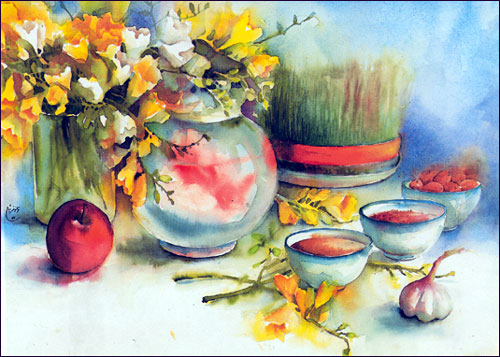|
The Persian New Year (Norouz=new day) is celebrated on the first
day of spring and is tied to the spring equinox. According to the
epic Persian poem, Shahnameh, Norouz came into being several
millennia ago during the reign of the mythological King Jamshid.
Through defeating the demons (divs), and bringing prosperity to his
subjects, Jamshid became master of everything but the heavens. To
reach the heavens, Jamshid ordered a throne built entirely of
jewels. When the throne was ready, Jamshid sat on the jeweled
marvel and ordered the demons to lift him to the sky.
Persian people were amazed at their King's power and showered him
with jewels and treasures. The day was called Norouz or new day and
was recognized as the first day of the year. The great poet
Ferdowsi recounts that for 300 years the people knew nothing of
death, hardship or sadness and the demons were chained as slaves.
However, Jamshid's power corrupted him and he began seeing himself
as God. Jamshid's arrogance was his undoing and with his words, he
fell from the grace of God. The centuries of prosperity and
immortality ended and disorder and misfortune rained upon his
kingdom.
Norouz, however, survived Jamshid's demise. In fact, Norouz
survived invasions by Greeks, Arabs, Turks, and Mongols.
Norouz has proven to be the most important cultural celebration for the
millions of Iranians living inside Iran as well as the diasporic
population.
The celebration of Norouz really starts on the last Wednesday of
winter known as Chaharshanbeh Soori. Bonfires are lit, and people
leap over the flames reciting the verse "sorkhi-e to az man,
zardi-e man az to" (translated as"give me your red and healthy
color and take my yellow pallor). Fire was a sacred blessing for
the ancient Persians.
Before the actual day of Norouz Persians also prepare and set a
special spread known as the Haft-Sinn, or the seven S's. Seven was
considered a lucky number and the spread contains seven items which
begin with the letter S in farsi. It is believed that Norouz was a
celebrated ritual of the Babolians, and the Sumarians.
Today the seven S's are typically: Sabzeh (home grown sprouts);
Samanou (wheat germ); Sib (apples); Sonbol (hyacinth); Senjed
(jujube fruit); Seer (garlic); Somagh (sumac);.In addition to the
seven S's, each Iranian family according to their religion places
what they believe in- i.e. Muslims place the Quran, rosewater,
painted eggs. But, generally everyone also includes: gold coins,
goldfish in water, a mirror, pomegrantes, and candles. And each
item symbolizes something, for example the sprouts and samanou
represent the rebirth of spring; apples and jujube represent beauty
and birth; rosewater and hyacinth bring sweetness; goldfish
represents life; garlic and sumac represent health; the coins bring
prosperity; and the candles represent light and goodness.
Norouz lasts for 14 days, during which time people visit their
relatives, starting with the eldest, their friends, and neighbors.
Children, depending on their parents' income, wear brand new
clothes, and receive money from their older relatives. The last day
is celebrated by picnic in the parks and by the rivers.
|

